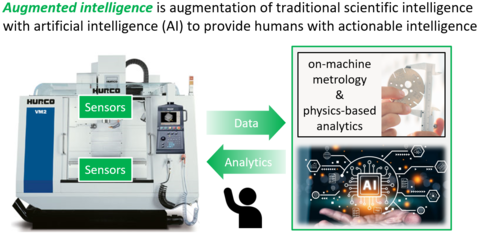Summary
The U.S. economy depends on manufacturing as a significant contributor for jobs, the nation’s economic output, and the production of goods for the world. Likewise, U.S. manufacturing depends on its 500,000+ machine tools that make precision parts. However, a major problem with these machines is that their performance, which degrades over time due to operations, is typically not monitored, resulting in unplanned downtime and the loss of revenue as machines fail or machined parts exceed their specifications without warning. Hence, manufacturing needs smart machine tools that are self-aware via on-machine measurements and diagnostics, to track the machine’s performance health. Furthermore, solutions must be non-invasive, data-rich, inexpensive, and accurate to be used by every machine tool to enable optimized production of assets within manufacturing facilities. Augmented intelligence, which is the augmentation of traditional scientific intelligence with artificial intelligence (AI) to provide humans with actionable intelligence, is envisioned as a disruptive catalyst for this future of smart manufacturing. Augmented intelligent solutions use on-machine sensors for measurements before and during manufacturing processes, analyze the data with a fusion of metrological approaches and machine learning, and monitor and predict the performance of machines and their processes. Smart machine tools assess and predict their health and the performance of their processes in real time to optimize production quality and yield.
The Augmented Intelligence for Manufacturing Systems (AIMS) project develops augmented intelligent solutions for manufacturing systems via methods, testbeds, deployable systems, reference datasets, uncertainty quantification, guidelines, and standards. The AIMS project includes proof-of-concept deployable solutions that enable reference datasets, demonstration with industry, technology transfer, and eventual standardization. Stakeholders and collaborators include part manufacturers, machine tool manufacturers, technology developers and integrators, AI researchers, and manufacturing software developers. Through reference datasets, technology transfer, and incorporation into standards, augmented intelligence will be adopted to advance U.S. manufacturing.
Description

Objective
To overcome existing measurement challenges via augmented intelligence, the fusion of integrated metrology, physics-based models, and artificial intelligence, to enable monitoring, diagnostics, and prognostics of manufacturing systems and their processes.
Technical Idea
One research direction that fulfills NIST’s mission and leverages the expertise of the Engineering Laboratory (EL) is to research new methods for manufacturing that fuse traceable techniques (metrology) and physics-based models with non-traceable techniques (artificial intelligence). This fusion is called “augmented intelligence” since traditional intelligence (measurement science and physics) is augmented by artificial intelligence (AI). Physics-based models approximate physical reality, while AI models can find complex structures and relationships but lack the explainability and reliability of physical models. As the physical relationships among sensor data become more complex, and as the amount of data increases, AI can be leveraged to “fill in the gaps” of simple physical models. Augmented intelligence will enable real-time monitoring, diagnostics, and prognostics for machines and processes within applications ranging from conventional (subtractive) manufacturing to semiconductor manufacturing.
Research Areas
The AIMS project seeks to develop augmented intelligent solutions for manufacturing systems and their processes via the following tasks:
- Advancement of augmented intelligence for machine tool linear axes
- Improvement and implementation of vision-based thermal drift monitoring for machine tools
- Testing and data-driven method development for improved real-time cutting force and displacement monitoring with instrumented tool holder and metrology suite
- Development of augmented intelligence for wafer flatness monitoring and critical dimension inference within semiconductor manufacturing
Highlights
- ASME B5.64 (“Methods for the Performance Evaluation of Single-Axis Linear Positioning Systems”) was first published in 2023 under the leadership of Dr. Vogl
- Gregory W. Vogl, Ainsley Rexford, Zongze Li, Robert G. Landers, Edward C. Kinzel, M. Alkan Donmez, and Joe Chalfoun. 2023. “Vision-based thermal drift monitoring method for machine tools.” CIRP Annals – Manufacturing Technology. 72(1): 301-304. https://doi.org/10.1016/j.cirp.2023.04.053
- Gregory W. Vogl, Dominique A. Regli, and Gregory M. Corson. 2022. “Real-time estimation of cutting forces via physics-inspired data-driven model.” CIRP Annals – Manufacturing Technology. 71(1):317-320. https://doi.org/10.1016/j.cirp.2022.04.071
- Gregory W. Vogl, Kyle F. Shreve, and M. Alkan Donmez. 2021. “Influence of bearing ball recirculation on error motions of linear axes.” CIRP Annals – Manufacturing Technology. 70(1): 345-348. https://doi.org/10.1016/j.cirp.2021.04.07
- Patent (U.S. Patent Number: 11,085,793) issued for “Inertial Measurement Unit and Diagnostic System” on August 10, 2021: https://www.nist.gov/document/11085793-patent-image

